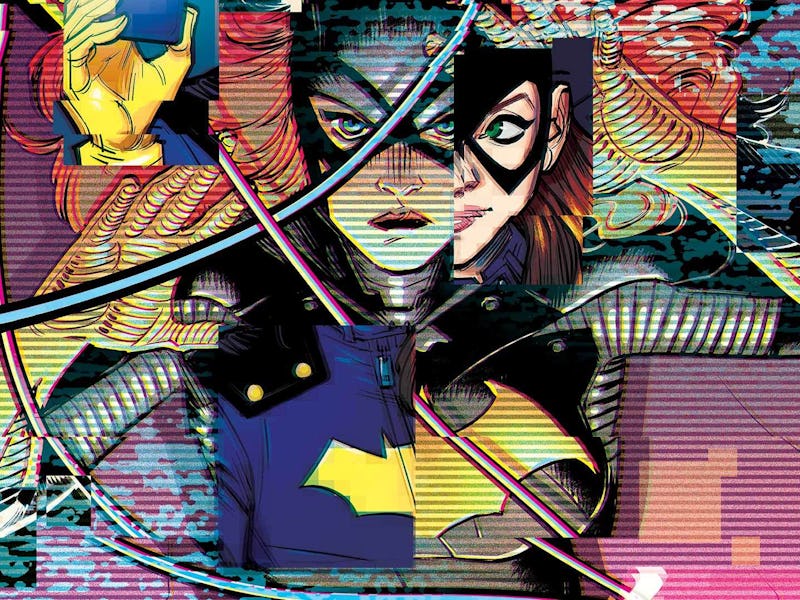Batgirl's Apperance in the 'Harley Quinn' Movie Could Solve Film's Internet Problem
The Internet as shown on films could use a comic book makeover, and Batgirl could be just the comic to do it.

DC is developing a film centered on Margot Robbie’s Harley Quinn, which is obviously exciting. The revelation that the film will also include a bunch of other DC leading ladies to join Quinn is arguably more thrilling, for several reasons. First, this means we’ll see characters like Batgirl and the Birds of Prey, including Black Canary and Huntress, in their DC cinematic debut alongside everyone’s favorite clown-themed villain (no, not him).
Batgirl, and the Birds of Prey, have spearheaded pretty great comics since DC started rebooting their cinematic franchises. Batgirl, in particular, has had a spectacular run in an arc called “The Batgirl of Burnside” written by Brenden Fletcher and Cameron Stewart, illustrated by Babs Tarr. In their story, Barbara Gordon moves to Burnside, the Brooklyn to Gotham City’s New York. Living the millennial lifestyle with hipster roommates, Barbara becomes Burnside’s newest hero while trying to move past the tragedy which had her paralyzed. The Batgirl of Burnside is a graduate student, a coder and programmer, and has an cybernetic implant which allows her to access her photographic memory and the internet.
Batgirl #38
This cyborg Batgirl presents a unique opportunity for the Harley Quinn filmmakers. If the producers behind the upcoming movie decide to take advantage of the new Batgirl run — which is likely, because the comics skew younger and feature Black Canary as a main player — they will undertake an adaptation of one of the best contemporary stories using social media and the internet as a narrative tool. Through the story and visual design, the recent run of Batgirl is a fantastic template for movies to follow when incorporating the internet into visual rhetoric.
Let’s back up. Movies suck at visualizing the internet. In Hollywood’s eyes, the internet isn’t cool unless it’s a weird CGI mess of neon lasers shooting from one place of the globe to another like some abstract, sci-fi concept. The internet has been portrayed as everything from abstract lines of code, which mean nothing, to just beams of light that are also pretty much nothing.
Batgirl of Burnside
The team of Fletcher, Stewart, and Tarr understood the fluidity and ubiquity of the web when they incorporated a Tinder-like social media platform/app “Hooq” as a key part of their Batgirl story. It isn’t so much that they bring in a relevant service like Tinder into the fictional DC universe; it’s that they also use the colloquial language surrounding a dating service like it. When we discuss the internet, we do so in tangible terms that don’t sound cheesy or trite. It’s a pretty amazing set of rules to translate from reality to page, and then to screen. To tell this Batgirl story would be to adapt their pretty elegant approach to the internet.
First, the creative team behind Batgirl humanizes the internet by having real people behind the apps. Barbara Gordon’s roommate is a developer for Hooq, giving a face to the social media platform. The comics interweaves social media into the fabric of Barbara’s circle of friends. Seemingly everyone in Burnside uses the app, and its appearance in everyday conversation doesn’t feel forced. In fact, Hooq is just one of many different facsimiles of real-life apps that flood Burnside, and seeing the use of Instagram or Facebook style services across the city only strengthen the story’s dedication to incorporating social media and the internet into an action-packed, progressive Batgirl story.
Hooq. Swipe right for Batgirl.
Secondly, Hooq is used as a platform to launch a discussion on another, very real, consequence of today’s information mining technology: invasion of privacy and online personal spaces. While jokes are made at the expense of the ever-present dick pic, the first villain in the arc embodies some of the worst of today’s predatory internet practices. Riot Black is a raving loon who speaks in hashtags and blackmails innocent people with their stolen online data. It turns out, he is just the first in a long line of stories which revolve around internet topics like identity theft, search histories, all leading up to a reveal that manages to tie Batgirl in with the failed predictive threat analysis of the Patriot Act and drone warfare.
Third, the comics seem to have reversed engineered a visual trick used by recent movies to show specific speech bubbles as stylized renders of popular app screens. Some speech bubbles echo text messages, IMs, Instagram feeds, and Twitter profiles. It turns the floating text message visuals seen in a lot of recent movies and takes it a step further, incorporating specific design elements into account, giving each message a visual context along with the implicit understanding of how exactly these messages are seen in a broader context.
Batgirl
Ultimately the story of Batgirl in Burnside is treated much like a glitch in the matrix. Her sudden reboot from the wheelchair-bound Oracle to Batgirl is almost literal, and the tech-saavy creators of the story play around with a lot of cyberpunk tropes, androids, avatars, and hacked mainframes. It also manages to turn one of the best superhero comics into a great examination of the internet in our social lives, seamlessly blending technology with the more human elements necessary to make technology relatable.
While the Burnside story might seem a little at odds with the very serious Batman v Superman DC universe, DC seems to be open to the idea of loosening their ties, and perhaps Batgirl and Harley Quinn will help bridge them towards a lighter film series that can still tackle serious questions.